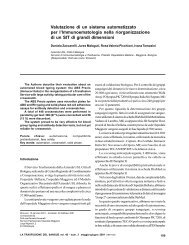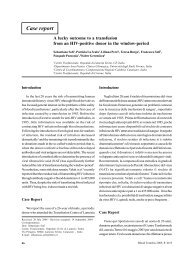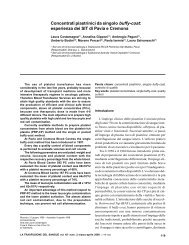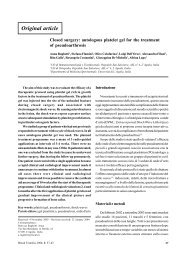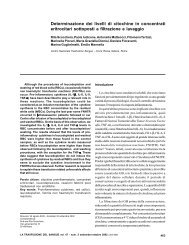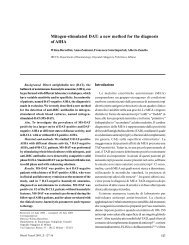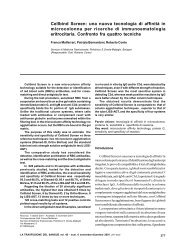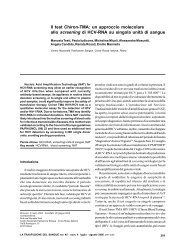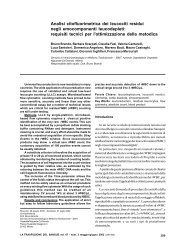Liumbruno GM et al.Thus, the lack of laboratory data we found seems to begreater than the 34.1% reported by other Authors 16 ; thisdifference is probably due to the different design of thestudy mentioned, which also evaluated the laboratory dataof patients transfused with FFP, with the aid of a specificdatabase. Both results were, however, encouraging in thelight of the data from the Sanguis study in 1994, whichfound that PT data were missing in 84% of the <strong>transfusion</strong>recipients of FFP in 43 European hospitals 43 .In second place as a cause of inappropriate use of FFP,was prophylaxis of bleeding (23.7% of inappropriaterequests). <strong>Transfusion</strong> therapy with FFP to correctcoagulation test abnormalities before carrying out invasiveprocedures is a common clinical practice, even if there areno "evidence-based" guidelines on this issue. Haemostasisis a complex process of interactions between pro-coagulantmolecules, platelets, natural anticoagulants, the fibrinolyticsystem <strong>and</strong> the endothelium. The screening tests ofhaemostasis prior to surgery are usually PT/INR <strong>and</strong> PTT;these laboratory tests have been developed to identifycauses of bleeding in patients with a demonstratedhaemorrhagic diathesis (high pre-test probability) <strong>and</strong> notto evaluate haemostasis in patients with a negative historyfor haemorrhage, nor has it been demonstrated that theyare able to do so. The <strong>transfusion</strong> of FFP before an invasiveprocedure, in order to correct mild to moderate changes incoagulation tests, is not, therefore, able to correct theanomaly or to reduce the perceived haemorrhagic risk 44-54 .The use of FFP to correct hypoproteinaemia or fornutritional purposes is greater in developing countries, butit is difficult to find a justification for this practice in theItalian health care system 19 .The present study also reveals that inappropriate useof FFP is more common in University hospitals than insmaller, peripheral hospitals, as already reported in theliterature 18 ; this could be due to the greater complexity ofcases treated in the University hospitals <strong>and</strong> the greateramount of blood components distributed by thesehospitals, both factors which could limit the possibility ofcarrying out audits <strong>and</strong> adhering to guidelines.Possible limitations of this study are: a) that the auditdid not use information technology, which, with a specificdatabase, would have enabled a whole set of diagnostic,clinical <strong>and</strong> laboratory data to be processed <strong>and</strong> comparedat national <strong>and</strong> international levels 16,41,55-57 ; b) the definitionof inappropriateness did not take into account the dose ofFFP used <strong>and</strong>, therefore, the possible administration ofsubtherapeutic doses 19,41,46,58,59 ; c) the comparison betweenthe years was not homogeneous, because the data for 2005were not divided by semester, but referred to the wholecalendar year.The capacity of <strong>transfusion</strong> structures to make dataavailable systematically <strong>and</strong> continuously on the use ofblood components is an essential feature of clinicalgovernance 60 ; systematic clinical auditing, particularly ifperformed at a large scale such as regionally, thus enablingthe acquisition of a substantial quantity of data, increasesthe degree of appropriate behaviours in the field of<strong>transfusion</strong> therapy, contributes to self-sufficiency, <strong>and</strong>can direct clinical research towards those sectors in whichinappropriate treatment is greatest. <strong>Transfusion</strong> <strong>medicine</strong>is, in fact, a transversal medical discipline in which thereare few adequately structured trials that provide evidenceon the indications <strong>and</strong> efficacy of <strong>transfusion</strong> therapy.Appropriately designed clinical trials could modify somedecisions, so that they are made on "evidence-based"criteria 61 . This is what is happening in the USA, where amulticentre clinical trial should provide evidence on whichto decide on the clinical use of FFP in patients with liverdisease <strong>and</strong> INR values of 1.3 - 2, who are c<strong>and</strong>idates forinvasive procedures 61 ; this multicentre study was triggeredby a retrospective audit 53 , followed by a prospective audit 48 ,conducted in the same hospital, <strong>and</strong> a systematic review ofthe literature on the subject 49 .References1) Catalano L, Abbonizio F, Giampaolo A, et al. Registronazionale e regionale del sangue e del plasma. Rapporto 2005.Istituto Superiore di Sanità. Available at: http://www.iss.it/binary/publ/cont/06-30.1163668346.pdf.2) Sullivan MT, Cotten R, Read EJ, et al. <strong>Blood</strong> collection <strong>and</strong><strong>transfusion</strong> in the United States in 2001. <strong>Transfusion</strong> 2007;47: 385-94.3) Greinacher A, Fendrich K, Alpen U, et al. Impact ofdemographic changes on the blood supply: Mecklenburg-West Pomerania as a model region for Europe. <strong>Transfusion</strong>2007; 47: 395-401.4) Vamvakas EC. Epidemiology of blood <strong>transfusion</strong> <strong>and</strong>forecasts of dem<strong>and</strong> for blood. In: Vamvakas EC, editor.Evidence-Based Practice of <strong>Transfusion</strong> Medicine, Bethesda:American Association of <strong>Blood</strong> Banks; 2001. p. 177-99.5) Currie CJ, Patel TC, McEvan P, et al. Evaluation of thefuture supply <strong>and</strong> dem<strong>and</strong> for blood products in the UnitedKingdom National Health Service. Transfus Med 2004; 14:19-24.6) Yeh CJ, Wu CF, Hsu WT, et al. <strong>Transfusion</strong> audit of freshfrozenplasma in southern Taiwan. Vox Sang 2006; 91: 270-4.7) Catalano L, Abbonizio F, Hassan JH. Registro nazionale eregionale del sangue e del plasma. Rapporto 2001. IstitutoSuperiore di Sanità. Available at: http://www.iss.it/binary/publ/publi/0315.1109149613.pdf.8) Catalano L, Abbonizio F, Giampaolo A, et al. Registronazionale e regionale del sangue e del plasma. Rapporto 2002.82<strong>Blood</strong> Transfus 2007; 5: 75-84 DOI 10.2450/2007.0015-07075-84_Liumbruno.p65 8205/07/2007, 11.01
Appropriateness of FFP <strong>transfusion</strong>Istituto Superiore di Sanità. Available at: http://www.iss.it/binary/publ/publi/0341.1109236509.pdf.9) Catalano L, Abbonizio F, Giampaolo A, et al. Registronazionale e regionale del sangue e del plasma. Rapporto 2003.Istituto Superiore di Sanità. Available at: http://www.iss.it/binary/publ2/cont/04-36.1140439702.pdf.10) Catalano L, Abbonizio F, Giampaolo A, et al. Registronazionale e regionale del sangue e del plasma. Rapporto 2004.Istituto Superiore di Sanità. Available at: http://www.iss.it/binary/publ/cont/05-45.1141828723.pdf.11) Lomas J, Anderson GM, Domnick-Pierre K, et al. Do practiceguidelines guide practice? The effect of a consensus statement onthe practice of physicians. N Engl J Med 1989; 321: 1306-11.12) McClell<strong>and</strong> B. Effective use of blood components. In:Murphy MF, Pamphilon DH, editors. Practical <strong>Transfusion</strong>Medicine, Oxford: Blackwell Science; 2001. p. 65-76.13) Wilson K, MacDougall L, Ferguson D, et al. The effectivenessof interventions to reduce physician's levels of inappropriate<strong>transfusion</strong>: what can be learned from a systematic review ofthe literature. <strong>Transfusion</strong> 2002; 42: 1224-9.14) Picinini V, Abbonizio F, Catalano L, et al. Mappa dellestrutture trasfusionali esistenti sul territorio nazionale(aggiornamento 2005). Istituto Superiore di Sanità. Availableat: http://www.iss.it/binary/publ/cont/0394_9303_2006_I_06-S1.1145354064.pdf.15) O'Shaughnessy DF, Atterbury C, Bolton Maggs P, et al.Guidelines for the use of fresh-frozen plasma, cryoprecipitate<strong>and</strong> cryosupernatant. Br J Haematol 2004; 126: 11-28.16) Palo R, Capraro L, Hovilehto S, et al. Population-based auditof fresh frozen plasma <strong>transfusion</strong> practices. <strong>Transfusion</strong>2006; 46: 1921-5.17) Hui CH, Williams I, Davis K. Clinical audit of the use offresh frozen plasma <strong>and</strong> platelets in a tertiary teachinghospital <strong>and</strong> the impact of a new <strong>transfusion</strong> request form.Intern Med J 2004; 35: 283-8.18) Soutar RL, Jobanputra S, Tait RC. A two-phase audit offresh frozen plasma: a regional approach [letter]. TransfusMed 2004; 14: 75-6.19) Kakkar N, Kaurt R, Dhanoa J. Improvement in fresh frozenplasma <strong>transfusion</strong> practice: results of an outcome audit.Transfus Med 2004; 14: 231-5.20) Schofield WN, Rubin GL, Dean MG. Appropriateness ofplatelet, fresh frozen plasma <strong>and</strong> cryoprecipitate <strong>transfusion</strong>in New South Wales public hospitals. Med J Aust 2003;178: 117-21.21) Chng WJ, Tan MK, Kuperan P. An audit of fresh frozenplasma usage in an acute general hospital in Singapore.Singapore Med J 2003; 44: 574-8.22) Stainsby D, Burrowes-King V. Audits of the appropriate useof fresh frozen plasma. <strong>Blood</strong> Matters 2002; 10: 7-9.Available at: http://www.blood.co.uk/hospitals/library/pdf/bm10.pdf.23) Luk C, Eckert KM, Barr RM, et al. Prospective audit of theuse of fresh-frozen plasma, based on Canadian MedicalAssociation <strong>transfusion</strong> guidelines [letter]. Can Med AssocJ 2002; 166: 1539-40.24) Prathiba R, Jayaranee S, Ramesh JC, et al. An audit of freshfrozen plasma usage in a tertiary referral centre in a developingcountry. Malays J Pathol 2001; 23: 41-6.25) Beloeil H, Brosseau M, Benhamou D. <strong>Transfusion</strong> of freshfrozen plasma (FFP): audit of prescriptions. Ann Fr AnesthReanim 2001; 20: 686-92.26) Hameedullah, Khan FA, Kamal RS. Improvement ofintraoperative fresh frozen plasma <strong>transfusion</strong> practice -impact of medical audits <strong>and</strong> provider education. J Pak MedAssoc 2000; 50: 253-6.27) Marti-Carvajal AJ, Munoz-Navarro SR, Pena-Marti GE, etal. An audit of appropriate use of blood products in adultpatients in a Venezuelan general university hospital. Int JQual Health Care 1999; 11: 391-5.28) Jones HP, Jones J, Napier JA, et al. Clinical use of FFP:results of a retrospective process <strong>and</strong> audit outcome. TransfusMed 1998; 8: 37-41.29) Tuckfield A, Haeusler MN, Grigg AP, et al. Reduction ofinappropriate use of blood products by prospectivemonitoring of <strong>transfusion</strong> request forms. Med J Aust 1997;167: 473-6.30) Marconi M, Almini D, Pizzi MN, et al. Quality assurance ofclinical <strong>transfusion</strong> practice by implementation of the privilegeof blood prescription <strong>and</strong> computerized prospective auditof blood requests. Transfus Med 1996; 6: 11-9.31) Cheng G, Wong HF, Chan A, et al. The effects of a selfeducating blood component request form <strong>and</strong> enforcementsof <strong>transfusion</strong> guidelines on FFP <strong>and</strong> platelet usage, QueenMary Hospital, Hong Kong. British Committee for St<strong>and</strong>ardsin Hematology (BCSH). Clin Lab Haematol 1996; 18: 83-7.32) Schots J, Steenssens L. <strong>Blood</strong> usage review in a Belgianuniversity hospital. Int J Qual Health Care 1994; 6: 41-5.33) Thomson A, Contreras M, Knowles S. <strong>Blood</strong> componenttreatment: a retrospective audit in five major Londonhospitals. J Clin Pathol 1991; 44: 734-7.34) Barnette RE, Fish DJ, Eisenstaedt RS. Modification of freshfrozenplasma <strong>transfusion</strong> practices through educationalintervention. <strong>Transfusion</strong> 1990; 30: 253-7.35) Brien WF, Butler RJ, Inwood MJ. An audit of bloodcomponent therapy in a Canadian general teaching hospital.CMAJ 1989; 140: 812-5.36) Mozes B, Epstein M, Ben-Bassat I, et al. Evaluation of theappropriateness of blood <strong>and</strong> blood product <strong>transfusion</strong> usingpreset criteria. <strong>Transfusion</strong> 1989; 29: 473-6.37) Blumberg N, Laczin J, McMican A, et al. A critical survey offresh-frozen plasma use. <strong>Transfusion</strong> 1986; 26: 511-3.38) Hayes SL, Torella F. The role of hospital <strong>transfusion</strong>committees in blood product conservation. Transfus MedRev 2004; 18: 93-104.39) Organizzazione Toscana Trapianti (OTT). Attività didonazione e trapianto di organi, tessuti e cellule nella RegioneToscana. OTT Report 2005. Available at: http://www.salute.toscana.it/sst/ott/pdf/report_ott_2005.pdf .40) Hasley PB, Lave J, Kapoor WN. The necessary <strong>and</strong> theunnecessary <strong>transfusion</strong>: a critical review of reportedappropriateness rates <strong>and</strong> criteria for red cell <strong>transfusion</strong>s.<strong>Transfusion</strong> 1994; 34: 110-5.41) Rotschild JM, McGurk S, Honour M, et al. Assessment ofeducation <strong>and</strong> computerized decision support interventions forimproving <strong>transfusion</strong> practice. <strong>Transfusion</strong> 2007; 47: 228-39.42) Kanter MH. The <strong>transfusion</strong> audit as a tool to improve <strong>transfusion</strong>practice: a critical appraisal. Transfus Sci 1998; 19: 69-81.<strong>Blood</strong> Transfus 2007; 5: 75-84 DOI 10.2450/2007.0015-0783075-84_Liumbruno.p65 8305/07/2007, 11.01



